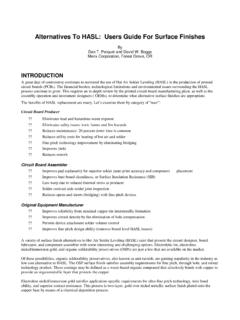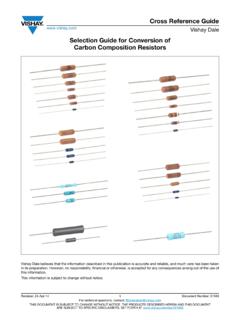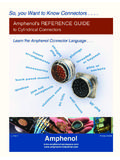Transcription of SPECIFICATION GUIDELINES - DDM Consulting
1 SPECIFICATIONGUIDELINESFORHOT AIRSOLDER LEVELINGREV 5A8 Delta DriveLondonderry, NH 03053 USAP hone:(603) 434-4156 Fax:(603) Issue Date: 06/04 define solder leveling capabilities and meaningful solder thickness measurement document will establish achievable solder thickness requirements that can be used forspecifying and standardizing solder thickness on printed wiring boards (PWBs). This document isintended to provide a common set of terms, definitions and measurement techniques for PWBmanufacturing and End User or OEM customer.
2 All information, requirements, and techniquesgiven in this document are based on the results of extensive testing and production beingprocessed through the component assembly process unless otherwise air leveling applies a coating of eutectic solder (Sn63) on copper surfaces of the printedwiring board. Solder protects the PWB from contamination and provides a uniform solderablesurface with extended shelf life ready for component assembly. Other coatings may be moreuniform (flatter); however, that does not guarantee solderability. Eutectic solder, as applied withHASL, is the most universally preferred coating.
3 It provides the longest shelf life, preferredsolderability, and shortest solder wetting times at : Middle of a feature (PAD). Some geometries will have crests at the center;some may not. (See definition of CREST). : Levelness from PAD to PAD over entire board, or within certainfeature size groups. This data is particularly helpful in determining thickness variations byfeature, used in determining solder paste dispensing volumes for component placement. Measure crests of all features being evaluated as one data group. Measure the centers of all features being evaluated as a second data DO NOT mix data groups.
4 The two data groups represent two (2) planes, centers and crests (referencediagrams below). : Highest point for a given feature (PAD). Since the process is geometricallydependent, smaller features on a given panel will tend to have a crest at the center of thefeature. Larger features will tend to have the crest off-center as shown in Paragraph (CENTER). This is due to normal surface tension and wet-back characteristics of thecopper and : The collection of X-Ray Florescence (XRF) GROUP: Data collected to show thickness range within a single feature size ordifferent feature sizes at given measurement locations.
5 A minimum of 24 points per groupis recommended for statistically meaningful data. When doing CPK* or CP* evaluations,a minimum of 50 points per group is recommended.* Note: CP is the Process Capability is the Process Capability Index which evaluated the systematic : Levelness within ONE PAD. To determine the range of solder thickness over a feature (PAD). A minimum offive (5) points should be measured over the feature. Measurement area typicallyexcludes the edge of the pad. See Paragraph for measurement techniques. The number of data points required will usually be determined by the end user;however, a minimum of 24 data points per pad is recommended.
6 + = MEASUREMENT POINT+ + + + + + + + + + + + + + + + + + + + + ++ + + + + + + + + + + + + ++ + + + + + + ++ + + + + + + + IMC:Intermetallic Compound. IMC formation is the key to soldering. It is a local alloying between the boundaryof the solder liquidus and the surfaces of the basis metals to which it is in contact,which is the essence of soldering. Without intermetallic formation, there is nosolder joint formation. Some processes, such as laser soldering, require only avery thin layer of IMC; however, IMC is required. High temperature and intimatecontact of the liquid solder enhance the rate and area of IMC formation.
7 Although IMC is required for the formation of the solder joint, the IMC layer itselfis not a wettable surface. That is why there must be sufficient additional eutecticsolder thickness to guarantee solderability at a solder thickness of 100 microinches ( microns) with 80microinches ( microns) of IMC, solderability or shelf life problems a solder thickness of 100 microinches ( microns) with to ( to microns) of IMC, solderability shall remainexcellent during : Average thickness for a given number of thickness WINDOW: The range between the lower control limit (LCL) and the uppercontrol limit (UCL).
8 Some processes require a 3 sigma distribution on critical features:MEAN [ 3 x Standard Deviation ] = Capable Process Window (Range)The capable process window, or 3 sigma distribution must fall within the specificationlimits (LCL, UCL). UNIFORMITY: Levelness from PAD to PAD within a single feature size or otherspecified data group. Measure one (1) geometry (feature size) only. Examples: calls out an Upper Control Limit (UCL) and Lower Control Limit (LCL) on 25 mil ( mm) pitch QFP sites with a specified CPK. Measure only 25 mil ( mm) pitch quad flat packs (QFPs). DO NOT mix data groups.
9 25 mil ( mm) pitch features = one data group 50 mil ( mm) pitch features = one data group 2. SPECIFICATION calls out 100 microinches ( microns) LCL and 1000 microinches ( microns) UCL (CPK is not specified). Measure all Data group in this case includes multiple feature sizes If only one (1) geometry (feature size) is measured, it should be the most criticalfeature (reference Paragraph ). Surface Mount FeaturesQFP = Quad Flat Pack, 4-sided, rectangular pad Leaded Chip Carrier, 2-sided rectangular pad = Ball Grid Array, circular dot pattern arrays in a square or rectangular Small to large, square or rectangular, normally in : The distance solder flows back over a copper feature after exiting the SURFACE: The copper surface must be clean and free of organic contaminantsand oxidation that restrict solder distribution within a feature or prevent solder fromadhering to the copper.
10 Other metal surfaces to be soldered have the same requirements;however, they are not covered in this GEOMETRY: The geometry of a feature will affect the thickness results at agiven leveling machine set-up. Large features tend to be thinner than small features on thesame side of the panel. This is due to surface tensions of the copper and solder and thedistance of the solder to wet-back on a given DATAThe most meaningful thickness verification data is obtained when it is properly grouped, usuallyby geometry and measurement grouping data is a useful inspection tool when used to establish or verify process compliance with customer specifications.







